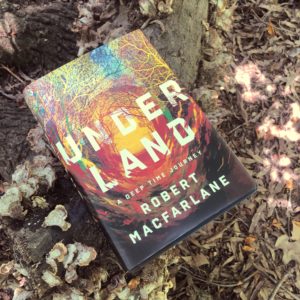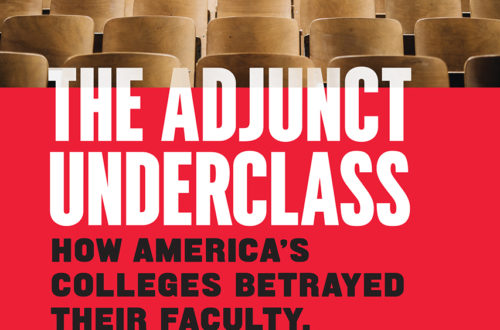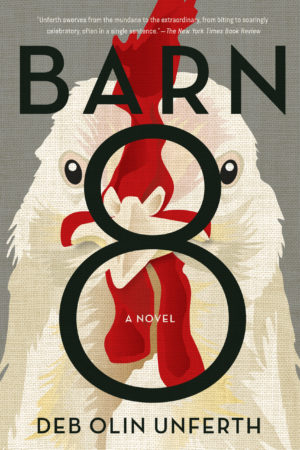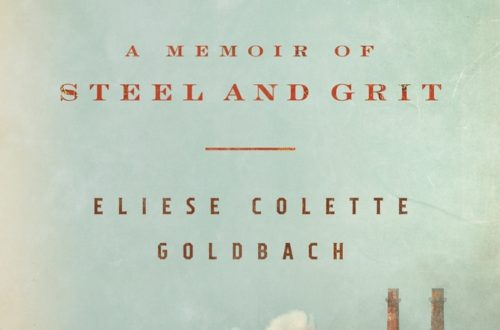
“Deep Time and Dark Spaces: Robert Macfarlane’s Underland” by S.N. Kirby
Under the earth is a world far stranger and far more mystical than our humdrum life here up top. Robert Macfarlane’s latest book, detailing these mysterious underground places, serves as part field guide and magic handbook for us surface dwellers. Underland weaves together a narrative of not just the earth and its underworld, but of the history, the present, and the future of mankind. This is not a book for the claustrophobic.
From the start, Macfarlane directly says that this was a book he intended to be less about humans and more about the mysteries below the earth; but even the best laid plans unravel. Turns out the story of the underground world is the story of us humans, because below us is a compilation of the things we bury there to forget for an eternity: our shame, our secrets, and our waste.
Macfarlane was given two objects to take with him in these ventures into the shadowland: an ash ball and an owl. Together, they represent the light and dark elements—such is the duality of above/below. Here is where the magic begins. Macfarlane’s detailing of these two magical objects are ancient in their construction and yet very much made in our modern times. He writes of the ash ball (the representation of darkness):
“The first of the objects is a double-cast bronze casket the size of a swan’s egg . . . Its maker wrote his demons down on a sheet of paper: his hatreds, fears and losses, the pain he had inflicted on others and the pain others had inflicted on him—all that was worst in his mind. Then he burned the paper and sealed the ashes inside the casket . . . It is an exceptionally powerful object, which possesses a ritual intensity of creation . . . I was given the casket on the condition that I disposed of it in the deepest or most secure underland site that I reached—a place from which I could never return.”
Where he places this object is for the reader to discover. There is a second object he brings with him to represent the visual “light” even in the depths of total darkness:
“The second of the objects is an owl . . . It is a talisman and what it connotes is magic . . . I was given the owl on the condition that I carried it with me at all times in the underland, to help me see in the dark.”
The ease in which Macfarlane dispenses this occult ritual and knowledge in and amongst pages on particle physics and mining feels right. In Underland nothing is random. There is a familiar mythical way Mafcarlane uses these two magical objects to shape the body of the narrative into a hero’s journey. The brief pauses Macfarlane employs to either physically touch or contemplate one or both of these items reminds the reader that he is indeed on a quest. And so, having been given these two objects, our protagonist descends into the realm of the underworld.
Underground Paris is perhaps one of the most integrated underbelly of a city imprinted on a collective consciousness. The long lines for the catacombs haunt tourists much longer than those old bones ever will. Macfarlane uses Walter Benjamin’s The Arcades Project to tap into the myths of the underworld in juxtaposition with the architecture of the human world:
“It is clear that Benjamin’s imagination was strongly drawn to enclosed and underground spaces: the warren of the covered ‘arcades’ themselves, as well as the caverns, crypts, wells and cells that existed beneath Paris. Taken together, these sunken spaces comprise what Benjamin called a ‘subterranean city,’ shadow twin to the ‘upper world,’ and dream-zone to its conscious mind. ‘Our waking existence is a land which at certain hidden points, leads down into the underworld,’ he wrote . . . .”
Any kind of magical ritual in this space would drive headlong into a social architecture, which is where Macfarlane picks up the narrative of the underground in today’s world. The collective space beneath Paris is inherently so strange and otherworldly, that one cannot help but shed their above ground personas into something more fluid in nature. This is the magic of the underground: the ability to transform oneself and one’s surroundings. Once inside, there’s an anarchist meets commune vibe to these spaces. A strict set of rules govern:
“Respect the past of the catacombs. Take out what you takin in. Resources are to be shared, even with strangers. No selling and no buying: barter-exchange or gift are they only acceptable modes of transaction. Help is to be given whenever necessary. Create with care—and do not destroy.”
Everything in those pages feels surreal. There are the three monkeys in a corner of an underground room, where MacFarlane and his companions sleep for the “night” (whatever night means to a place where the light is never seen). In one of the eyes of the monkeys a candle burns. Farther along the journey is a life size Tartarus, stuck forever in his trajectory out of a wall. A hidden room—so secretive that its name and location must not be revealed—encases a stone staircase with samples of stones, crystals, and metals on each of its steps. Emerging feels just as surreal. Butterflies transform into petals. Phantom music plays.
Where is Hell? Underground of course. The horror of the underground is sustained throughout cultures and time periods. Macfarlane writes: “A long cultural history of abhorrence exists around underground spaces, associating them with ‘the awful darkness inside the world,’ in Cormac McCarthy’s phrase.” This cultural horror of the underground feels entirely human in its construct. Under the earth is where we bury the dead along with their secrets of the atrocities done to them.
Macfarlane spins a story underneath the wild mountains of the Slovenian highlands that holds proof of humanity’s immense capacity for cold calculated violence and the culpability it holds. During the conflicts of World War II, some forty to eighty people are alleged to have been marched through the mountains. Where the earth opened up into a deep chasm, these people were killed en masse without mercy. More and more bullets and barbed wire are brought to the surface every day. War had come beneath the mountains and the horror was human’s own making.
Touch the owl and ash ball to remind the reader that we are on a mythical quest. Once again, myths about the underground transgress cultures and time periods. This time, the collective idea that pervades myth and storytelling is that of the underground as a place of passage to the spirit world. These are the “thin places” where “the borders between worlds or epochs feel at their most fragile.” Macfarlane recounts a journey to a place such as that in the caves of northern Norway. Dancing red figures decorate the walls. Researches can only guess from the artifacts left behind that the paintings are from 2,000 to 3,000 BCE. Magic is ancient.
Rites and ritual thrive in the underground. In these caves Macfarlane details the splashes of red, barely visible at first—as if the drawings themselves have become spirit like in nature. There are at once there and not there. He writes of these caves and rituals:
“Only shamans and the dead are able to pass between the tiers, by mean of an axis mundi that—in the form of a river or tree—connects the upper and lower spirit realms to the living present of the middle realm. Terje Norsted and Bjerck both propose that practices in the painted caves may have been rites of passage, permitting mortal movement—through the membrane of the stone—to the cosmic underland or overland.”
In this way, Macfarlane acts as shaman to the reader. He freely passes between this world of the dead below the surface and the world of the present in the here and now. With his final passage into the earth, he looks towards the future and the remnants of what we have left behind for our ancestors.
There is a different kind of rhythm to these unseen places. Time itself seems to work differently in the underground: “‘Deep time’ is the chronology of the underland. Deep time is the dizzying expanses of Earth history that stretch away from the present moment. Deep time is measured in units that humble the human instant: epochs and aeons, instead of minutes and years.” This ‘deep time’ of the underworld haunts Macfarlane throughout the text. Humans have put into the earth a vast amount of material: things to be remembered, things to be forgotten, and things so toxic that they must never be brought to the surface again. These are things that are crucial to the sense of deep time:
“At its best, a deep time awareness might help us see ourselves as part of a web of a gift, inheritance and legacy stretching over millions of years past and millions to come, bringing us to consider what we are leaving behind for the epochs and beings that will follow us.”
In that sense, the deep time of the underworld forces us to think beyond the disposability of the present and into the lasting effects of the future. There are things that are left to be forgotten and then there are things to be left behind and never touched again. What haunts Macfarlane most are not the remnants of war or bones, but are the toxic wastes we have poured into the earth.
The Waste Isolation Pilot Project in New Mexico is a terminal disposal site for nuclear waste. This is a waste so toxic that scientists and linguists are determining how to best communicate to future generations that this is a place never to be opened. A series of sealed chambers and backfilled access shafts are designed to deter entrance or excavation. Images of Qin Shi Huang’s fabled tomb lined with rivers of mercury come to mind. Except this time, those who built it are entrusted to keeps its location and the secrets it holds alive and well. Warnings are carved out in the walls. There are chambers upon chambers of rooms that hold countless messages in languages from all over the world. One warning, simply put, says it all:
“We are going to tell you what lies underground, why you should not disturb this place, and what may happen if you do.
This site was known as the WIPP (Waste Isolation Pilot Plant Site) when it was closed in 2038 AD.
The waste was generated during the manufacture of nuclear weapons, also called atomic bombs.
We believe that we have an obligation to protect future generations from the hazards we have created.
This message is a warning about danger.
We urge you to keep the room intact and buried.”
Of course, the words themselves have a half-life far shorter than the dangers foretell. Eventually they will fade away into the deep time of the underground. What remains looks and feels like a warning from ancient mummies: here lies things never to be disturbed. A curse upon those who do.
Macfarlane draws from the human compendium of knowledge to bring together the esoteric symbols and hard science of the underground world. From nuclear particle physicists to anarchistic urban explorers, Macfarlane’s book treks the vast amount of humanity that can be found in these seemingly dark and empty places. The power of this underground space mixed with the lyrical style of writing Macfarlane utilizes brings a hypnotic power to the text—almost as if Macfarlane is placating some unseen supernatural force below us.
His work is haunting in ways no horror writer could foretell. And yet, there seems to be a proverbial light in the darkness. Underneath us all are some of the best and worst aspects of humanity. The ability to create and destroy exist simultaneously in the earth. In spite of this, the communities he encounters are actively working to maintain the best of the past and to correct the worst of the future. We are all working to be better and to do better for those who will come long after we are gone. “Deep Time” may be on our side after all.
© LIT Magazine Issue #33, 2019




